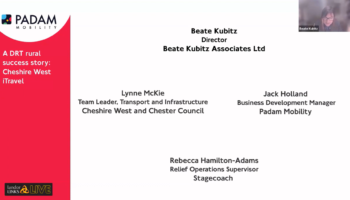The economic optimisation of on-demand services is arguably one of the main issues faced by PTAs and transport operators.
A misconception is that the more users an on-demand service has, the more expensive it becomes. In order to limit costs, operators therefore regularly adopt measures to limit the number of passengers. However, this rather leads to a deterioration of the quality of service and number of trips.
However, if a DRT service is based on a digital solution and automatic optimisation algorithms, costs can be reduced without affecting the number of passengers. It is even possible to reduce the cost per passenger and thus reduce the overall cost of the service.
So, what are the essential factors for success in optimising a DRT service in sparsely populated areas?
We distinguish between two categories: technical optimisation, i.e. which of the different functionalities of the deployed solution should be activated, and service optimisation, which concerns the configuration of these functionalities.
Optimisation of on-demand systems: Technical optimisation
Enabling or disabling certain features can reduce the cost of on-demand transport:
Demand forecasting: helps transport operators plan their service by predicting demand. The forecast uses data collected over time since the service was introduced and complements it with data collected during the ongoing operation of the service.
Multi-Stop and Intelligent Multi-Stop: These configurations make it possible to suggest a stop that is slightly further away from the preferred stop if neither the preferred stop nor the selected time slot can be offered. Urban areas are particularly well suited for this function due to the density of points of interest. With multiple stops and smart stops, it is possible to optimise vehicle routes by avoiding detours thus increasing ridership by up to 20%.
Filter: Optimisation of a DRT service is possible by manipulating the route suggestions. The most interesting filter is the bundling filter, which makes it possible to reduce the number of kilometres and thus reduce the cost of the service
Managing travel time: The optimisation of a dynamic DRT service is mainly based on the algorithm’s ability to calculate travel time. The more finely it is calculated, the better the optimisation…
Optimisation of on-demand systems: Service optimisation
The optimisation of DRT services involves the adaptation of the technical characteristics and the design of the service. In order to reduce the costs of on-demand systems, various service optimisations are possible:
Making a service more flexible and simple: When a service is subject to restrictions, e.g. in terms of stops or journey times, it will never be able to satisfy all individual needs of users. Here, simplifying the way it functions can help to increase the use of the service. For example, in Clamart (Haut de Seine), we have developed a free-floating service, the Clam’Express, which has enabled a 20% increase in ridership, from 1,000 to 1,200 passengers per month.
Service restrictions: If a service carries large passenger flows (multimodal hubs or stations, etc.), e.g. in the context of home-to-work trips, it may make sense to impose restrictions on the service in order to keep the vehicle fleet focused on these flows and to meet the demand. In Pau, the additional restrictions on the SAFIR Dial-A-Ride service have enabled the transport of 17 passengers per trip at peak times.
Better utilisation of the service: By adjusting the parameters of the service, such as the number of detours or time restrictions, local conditions can be better met and higher occupancy rates (passenger pooling) can be achieved. In this way, the service can be made more attractive for the same amount of resources. In Lincolnshire, a rural county in the UK, the local operator increased the number of detours to allow more users to be pooled on the same journey.
Modification of service configuration: This aspect concerns departure or arrival points of vehicles, times or spots of drivers’ breaks, location of parking depots. The configuration of the service layout can be modified. When using computational and optimisation algorithms, such configuration can increase the attractiveness of the service, in particular, because a reduction of waiting times and a better distribution of vehicles can be achieved. In Lyon, the analysis of the demand flows for the TCL on-demand service has shown the need to adapt the starting and ending points of the car parking areas so that they are closer to the origins and destinations of the users. In this way, waiting times have decreased while at the same time the pooling rate has increased.
Downsizing the vehicle fleet: Sometimes a service is suboptimal because there are too many vehicles in relation to the actual demand. In this case, it is possible to improve operational efficiency by reducing the fleet to a certain number of vehicles and/or at certain times. The analysis tools provided by Padam Mobility make it possible to determine the appropriate number of vehicles according to users’ demands.
Choose the right partner!
For the implementation of these various optimisation projects, it is essential to have a competent and reliable partner at your side. Customer proximity, responsiveness and expertise are the three criteria that authorities and operators should not compromise on when choosing their provider of digital on-demand solutions.
At Padam Mobility, we pay special attention to the everyday support of our customers. Our teams know their territories and challenges very well and can therefore make suitable suggestions for optimising DRT services. Moreover, all our solutions are 100% developed by public transport experts. We already support more than 80 different territories regarding their transport policy.
.
Find out more about Padam Mobility
You might also like this article: Demand-Responsive Transport: Explore and leverage the data of your service





